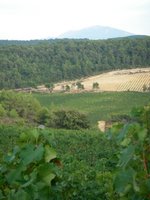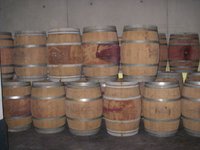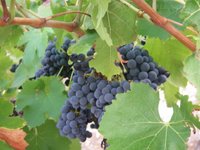 Last Thursday, we took an eight-hour wine tour in Cotes du Rhone. We tasted award-winning rosés in Tavel. We picnicked at the ruins of the Chateau du Pape (the antipopes' summer getaway) and drank Chateauneuf du Pape made from grapes harvested from a single acre that was planted in 1912. In the end, the most interesting stop was the Domaine de Mourchon, a relatively new vineyard run by a Scottish ex-pat and his son-in-law, Hugo (below). It's wine-making season in southern France and, while many of the vintners we met along the way eyed our cameras with suspicions of corporate espionage (might we be undercover agents for Yellow Tail?), Hugo was gracious enough to take us on a tour of their entire operation.
Last Thursday, we took an eight-hour wine tour in Cotes du Rhone. We tasted award-winning rosés in Tavel. We picnicked at the ruins of the Chateau du Pape (the antipopes' summer getaway) and drank Chateauneuf du Pape made from grapes harvested from a single acre that was planted in 1912. In the end, the most interesting stop was the Domaine de Mourchon, a relatively new vineyard run by a Scottish ex-pat and his son-in-law, Hugo (below). It's wine-making season in southern France and, while many of the vintners we met along the way eyed our cameras with suspicions of corporate espionage (might we be undercover agents for Yellow Tail?), Hugo was gracious enough to take us on a tour of their entire operation.Hugo is a heartbreaker. Standing in front of the large red doors of the winery, looking down on the rows of hundred-year-old  vines bearing loads of purple fruit, gazing soulfully at the mountains beyond, he began to explain his metier. "Sure, winemaking is a science," he said, "it's an art, it's a passion; but above all, in the end, it has to be a way of life." The women in our party melted visibly. The sun was setting over the hills and the vines were glowing above the rocky soil. You could almost see the wheels turning in the heads of our fellow tasters as they pondered whether it might not be worth trading in their pin-striped suits for the muddy jeans and beatific if wine-stained smile of one who lives in harmony with la terre.
vines bearing loads of purple fruit, gazing soulfully at the mountains beyond, he began to explain his metier. "Sure, winemaking is a science," he said, "it's an art, it's a passion; but above all, in the end, it has to be a way of life." The women in our party melted visibly. The sun was setting over the hills and the vines were glowing above the rocky soil. You could almost see the wheels turning in the heads of our fellow tasters as they pondered whether it might not be worth trading in their pin-striped suits for the muddy jeans and beatific if wine-stained smile of one who lives in harmony with la terre.
 vines bearing loads of purple fruit, gazing soulfully at the mountains beyond, he began to explain his metier. "Sure, winemaking is a science," he said, "it's an art, it's a passion; but above all, in the end, it has to be a way of life." The women in our party melted visibly. The sun was setting over the hills and the vines were glowing above the rocky soil. You could almost see the wheels turning in the heads of our fellow tasters as they pondered whether it might not be worth trading in their pin-striped suits for the muddy jeans and beatific if wine-stained smile of one who lives in harmony with la terre.
vines bearing loads of purple fruit, gazing soulfully at the mountains beyond, he began to explain his metier. "Sure, winemaking is a science," he said, "it's an art, it's a passion; but above all, in the end, it has to be a way of life." The women in our party melted visibly. The sun was setting over the hills and the vines were glowing above the rocky soil. You could almost see the wheels turning in the heads of our fellow tasters as they pondered whether it might not be worth trading in their pin-striped suits for the muddy jeans and beatific if wine-stained smile of one who lives in harmony with la terre.(Incidentally, our guide, Guy is a former rat-racer from London who gave it all up to drive other rat-racers around Provence on their holidays. He reported that he had once had a client from Vancouver who tasted too much wine and flew back to Canada to tender his resignation.)
So, we admired the view and imagined ourselves in overalls, while Hugo talked rapturously about terroir (the special characteristics of soil, clime and atmosphere that give a French wine its particular regional quality, and the subject of many an impassioned defense of French wine-making). The technique for growing suitable fodder for Domaine de Mourchon wines is to concentrate the energy of each vine (twisted, gnarly, low-lying growths that in no way resembled the vines we've seen in the wine-making regions of northern Michigan) into just two bunches of high-intensity grapes. They're tiny, round, and intensely sweet; it's hard to believe they could even be related to the pale green ovals we buy at the supermarket. At Hugo's behest, we tasted these wonderous orbs and crunched the pits as well to get a sense of the taste of tannins, the astringent, tactile qualities of red wines that come from the skins and seeds of the grapes. Let's just say that grape seeds are not going to be taking the American snack market by storm any time soon.

We had watched some sturdy French farm boys picking grapes earlier in the day, and were confident that we had this part of our future career as oenologists down pat (the secret is to make your help wear really great hats). As he led the way to the fermenting room, Hugo explained that after harvest, the grapes are stripped of their leaves and stems, goosed (oo la la) to release their juices, and piped into tanks for the first of two fermentations. Stepping into the room with high hopes of viewing a scene of dark-haired French virgins holding up their skirts to dance barefoot in huge wooden buckets of grapes, we
 were instead met with the sight of these monstrous metal vats. Hugo's rapture was undiminished, and he gleefully filled a large glass with the alarmingly purple concoction and invited us all to take a swig (with the slightly alarming warning that we were not under any circumstances to swallow it; perhaps it magically confers a perfect French accent, or some other such carefully guarded secret). We all spit it onto the floor with gleeful abandon.
were instead met with the sight of these monstrous metal vats. Hugo's rapture was undiminished, and he gleefully filled a large glass with the alarmingly purple concoction and invited us all to take a swig (with the slightly alarming warning that we were not under any circumstances to swallow it; perhaps it magically confers a perfect French accent, or some other such carefully guarded secret). We all spit it onto the floor with gleeful abandon.The second fermentation takes place in cement casks, after  which the expert palates start mixing grapes for that elusive perfect combination. By law, Cotes du Rhone wines must be at least fifty percent Grenache, but often include Syrah, Mourvedre, and a number of other local varieties. Once a final solution is agreed upon, the wines are aged either in oak barrels (barriques) or cement casks and then bottled.
which the expert palates start mixing grapes for that elusive perfect combination. By law, Cotes du Rhone wines must be at least fifty percent Grenache, but often include Syrah, Mourvedre, and a number of other local varieties. Once a final solution is agreed upon, the wines are aged either in oak barrels (barriques) or cement casks and then bottled.
 which the expert palates start mixing grapes for that elusive perfect combination. By law, Cotes du Rhone wines must be at least fifty percent Grenache, but often include Syrah, Mourvedre, and a number of other local varieties. Once a final solution is agreed upon, the wines are aged either in oak barrels (barriques) or cement casks and then bottled.
which the expert palates start mixing grapes for that elusive perfect combination. By law, Cotes du Rhone wines must be at least fifty percent Grenache, but often include Syrah, Mourvedre, and a number of other local varieties. Once a final solution is agreed upon, the wines are aged either in oak barrels (barriques) or cement casks and then bottled. All in all, an enticing mix of ancient technique and shiny new science. We went up to taste the results of all this labor in the tasting room, a rather yuppified space giving little indication of
 the processes of creation, and were rewarded with some lovely reds.
the processes of creation, and were rewarded with some lovely reds. 





1 comment:
Watch out for those sturdy French farm boys. I think I saw them in Pauline does Provence.
U.Ed
Post a Comment